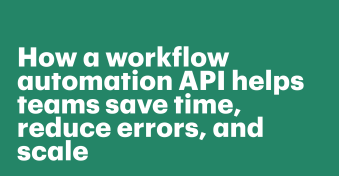There’s a ceiling to how far you can scale with manual contract creation.
If your team is growing fast, handling more complex deals, or juggling high volumes of customer activity, it might be time to level up how contracts are created and delivered.
Copying data from internal tools, duplicating templates, or manually formatting docs can quietly eat away at your team’s efficiency and introduce unnecessary risk at critical moments.
That’s where automation and embedded experiences come in.
By connecting your document workflows directly to your CRM, billing systems, and customer-facing platforms, you can move faster, reduce errors, and create a seamless end-to-end experience for your team and your customers.
If any of the signs below sound familiar, it might be time to activate the next phase of your PandaDoc setup — with automation powered by our API.
What’s an API and what does it do?
API stands for Application Programming Interface, but don’t let the jargon throw you off. Think of an API like a digital connector or messenger that lets two systems talk to each other.
In the context of PandaDoc, an API allows your existing tools — like your CRM, billing system, or web platform — to tell PandaDoc exactly when to create a document, what content to include, and who to send it to. It all happens automatically behind the scenes.
Here’s a simple way to think about it:
- Without an API: Someone on your team has to open PandaDoc, choose a template, copy and paste info from another system, then send the doc manually.
- With an API: Your systems do that work for you. A new deal closes in Salesforce? PandaDoc automatically creates and sends the right contract. A customer submits a form on your website? PandaDoc instantly generates a quote, right inside your platform.
It’s not about replacing your team. It’s about removing the repetitive parts of their job so they can focus on closing deals, helping customers, or scaling smarter.
The best part? Your customers don’t even see the backend. They just experience a smoother, faster, more seamless interaction, all thanks to the quiet power of an API.
How can you tell if an API is right for you?
1. You’re copy-pasting from internal systems
If your team is still transferring data manually from your CRM, ERP, billing platform, or internal tools to generate documents, that’s more than a workflow inefficiency; it’s a growth risk.
Copy-paste might seem quick, but it introduces human error, wastes time, and breaks the connection between your source systems and final outputs.
When your data already exists in a system of record, there’s no reason a person should have to move it.
The moment someone needs to check multiple data sources, find a deal, open a template, and paste in fields, your team is spending time on work that could be automated.
With PandaDoc’s API, you can connect your source systems directly to your document generation process.

Data flows automatically into your document templates, eliminating manual data entry and ensuring that every document is accurate, consistent, and created the moment it’s needed.
2. You’re repeating the same document tasks dozens of times a month
When your team is creating the same type of quote, contract, or NDA more than 20 times a month, repetition becomes overhead.
It slows your sales team, clogs your workflows, and adds risk every time a field is filled manually.
Templates can help, but they still rely on manual steps.
And when volume increases, it’s only a matter of time before someone sends the wrong doc version or forgets to update a key term.
Automated document workflows eliminate that risk. With PandaDoc’s API, you can trigger document creation based on conditional logic, like a deal moving to a new stage or a form submission.
The doc is generated automatically, using the right template and the right data, without manual input. It’s fast, accurate, and repeatable at scale.
3. You’re redirecting users away from your product to sign documents
If you’re asking users to leave your product, whether it’s a sales portal, onboarding flow, or customer dashboard, just to review or sign a document, you’re introducing a silent source of friction.
It might not seem like a big deal. But to your customers, it can feel clunky, confusing, or even untrustworthy.
This type of disjointed experience is more than just a UX issue; it’s a revenue risk.
Every extra click, redirect, or login prompt adds friction. And in a high-stakes moment like signing a contract or approving a quote, that friction can frustrate users enough to abandon the process entirely.
Embedded document experiences solve this. With PandaDoc’s embedded API capabilities, you can keep users inside your platform from start to finish.

Documents load natively within your UI — no redirects, no broken branding, no additional login screens. Just a seamless, intuitive flow that builds trust, reduces drop-off, and helps you close more deals faster.
4. You’re manually sending documents tied to time-sensitive events
Manual document sending doesn’t scale, especially when speed is critical. If your team is responsible for noticing when a trigger event happens and manually generating the right doc, delays are inevitable.
Whether it’s onboarding paperwork for a new hire, a contract for a closed-won deal, or an updated quote after a form submission, time-sensitive workflows need real-time execution. Every hour matters. Every delay creates friction.
PandaDoc’s API enables truly automated end-to-end document workflows. When the triggering condition is met, the document is generated and sent instantly, with no reminders or missed steps.
This is the kind of responsiveness that keeps deals moving and delivers a better customer experience.
5. You’re growing fast — and your doc processes can’t keep up
Growth is a great problem to have. But when deal volume spikes, teams expand, and customer activity ramps up, the cracks in your document process start to show.
What once felt manageable suddenly becomes a scramble to keep up, and manual tracking is often the first thing to break.
If your team is updating spreadsheets, checking Slack threads, or chasing status updates across tools just to figure out who signed what, it’s a clear sign your current setup wasn’t built for scale.
The problem isn’t just the time spent tracking, it’s the lack of visibility and control that slows everyone down.
With PandaDoc, you can unlock real-time insights into every document event — from views and completions to comments and expirations — and sync that data directly into your CRM or reporting tools.

That means no more guesswork, no more back-and-forth, and no more growing pains.
And if you’re scaling fast, this is the kind of infrastructure that keeps your momentum going.
You’re scaling volume, not efficiency
As your business grows, so does your document volume. But adding more headcount just to create, send, or track documents isn’t sustainable. Manual workflows aren’t built for scale. They require constant oversight, introduce variability, and limit how fast you can move.
If you’re scaling output but not efficiency, you’re hitting a ceiling.
With PandaDoc’s API, you can build document workflows that match your scale. Whether you’re sending 100 or 10,000 documents a month, the process remains consistent, secure, and fast.
Your team focuses on strategy and outcomes, not repetitive doc tasks.
Upgrade your contract creation process
If your team is still relying on manual contract creation, now is the time to explore a better way.
With PandaDoc’s API, you can create fully automated workflows that connect to your systems, eliminate errors, and accelerate every step — from creation to completion.
Disclaimer
Parties other than PandaDoc may provide products, services, recommendations, or views on PandaDoc’s site (“Third Party Materials”). PandaDoc is not responsible for examining or evaluating such Third Party Materials and does not provide any warranties relating to the Third Party Materials.


